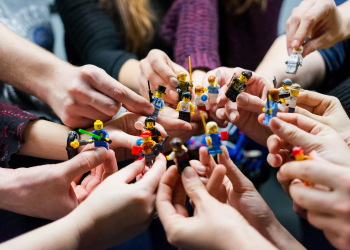It’s been a tough year for everyone since the COVID-19 crisis began. Some organisations are adapting and holding their own using this time to repurpose, reinvent, and consolidate. Some have been hit very, very hard. Most leaders are struggling with the extreme uncertainty existing within their operating environments, and are seeking to prepare and manage for what might come next. At the same time, they are seeking how to keep their people and teams engaged and moving forward in a world, where the work environment and the nature of work is going through unprecedented change, and the only way to navigate it is by effectively dancing at the edge of your comfort zone.
It seems that we need to explore and set the most useful strategies towards cultivating the most resourceful psychological and neurological resources to survive and thrive through extreme uncertainty and chaotic times.
It’s possible as well as rewarding to do this, by hitting our pause buttons to reconnect, rethink, reimagine and reframe your possibilities for a purposeful future by:
- Understanding and maximising the convergence of new mindsets, and calling for new forms of leadership, new ways of working, and new operating models.
- Developing innovation agility, being adaptative, and cultivating mental toughness, emotional agility, to build resilience and trust in times of extreme uncertainty
- Developing tolerance of ambiguity and a culture of constant refinement, review, and revision.
- Being brave, courageous, and bold by knowing what it means to successfully dance on the edge of your comfort zone.
What is a comfort zone?
According to an article in Psychology Today a comfort zone is a psychological/emotional/behavioural construct that surrounds and defines the routine of our daily lives. Being in your comfort zone implies familiarity, safety, and security, a life that often simply lows with the ebbs and tides, usually causing us to take the path of least resistance.
Yet, the range of unprecedented challenges resulting in the extreme uncertainty in our current operating environments is forcing and pushing many of us to unwillingly abandon and exit our comfort zones. This is because the patterned worlds of our business as usual existence, which traditionally kept us relatively comfortable and calm, and helped us stay emotionally and mentally even, free from anxiety and worry to a great degree, are no longer certain, or stable.
In fact, more than ever, for some of us, just getting through our daily lives right now is leading to stress, overwhelm, and burnout, all of which impact negatively our health, wellbeing, and ability to achieve optimal performance.
This is why so many people are, or have been feeling anxious, insecure, vulnerable, powerless and, as a result, are feeling fearful and out of control in the current environment of extreme uncertainty.
Why is this so?
As humans, we all have an internal need for consistency, which is represented by our internally mapped, largely unconscious comfort zones. When we experience cognitive dissonance, as we experience in an extremely uncertain operating environment, we encounter an apparent inconsistency between what is really happening and what we believe to be really true.
As result, we unconsciously slip into auto-pilot, which includes a range of varied aggressive and passive defensive, reactive responses such as avoidance denial or anger and opposition. Often described as retreat, freeze, or take flight or oppose reactions to what is “seemingly” going on. This is because we distort our thoughts or feelings into believing that have no control over events, which is a normal and natural survival mechanism that enables us, in some way, to cope with the situation.
This results in feelings of discomfort, which most of us will do anything to move away from – to avoid any types of pervasive, visceral, challenging thoughts and feelings, derived from our conflicting beliefs and values. This is because we all have auto-responses or neurological urges to correct these and remove the discomfort, which results in procrastination, excuses, denial, avoidance and justification, and ultimately, inaction.
Cultivating discomfort resilience
Because to respond, be proactive, evocative and flow with extreme uncertainty, and in this paradoxical situation successfully, it is crucial to create both the safe space, and the psychological safety that allows people to feel uncomfortable/overwhelmed, and to then help them to be comfortable with being uncomfortable as a way of life, which we call “discomfort resilience.”
We can do this by supporting people to develop “discomfort resilience” through intentional mindset shifting and by cultivating emotional agility and mental toughness.
Mindset matters most
In our last blog Controlling the Controllables we suggested that there is one thing that we can all control, and is controllable, which is our mindset – how we think, feel and choose to act.
We all have the option to pause, retreat and reflect and make conscious choices to shift us out of reactivity and towards taking responsibility to shift and control, the way we may be thinking, feeling, and acting in the face of our current range of challenging situations.
To do this by confronting and letting go of our deepest fears, by stepping up and out of the Fear Zone, by shifting our mindsets, to safely go dancing on the edge of your comfort zone.
Why go dancing on the edge of your comfort zone?
In normal times, creating a comfort zone is a healthy adaptation for controlling much of our lives. Yet having the boldness, bravery, and courage in extreme uncertainty, to step up and out of our comfort zones helps us be agile and adaptive in transitioning, growing, and transforming through the enormous challenges, disruptions, and adversities we are confronting.
In fact, once we do take the first baby steps out of our Fear Zone (fear of loss, blame, shame, envy, punishment, retribution, opposition, being controlled, humiliation, being envied or made wrong) we enter the Learning Zone.
Being in the Learning Zone is the first stopping point toward generating creative energy:
- Facing, feeling, and letting go of some of your fears,
- Dealing realistically, without bias and distortion, with your problems and challenges,
- Learning, in a “fail fast culture”, making mistakes are opportunities for learning,
- Acquiring new mindsets, behaviours, and skills that essentially expand your comfort zones,
- Understanding and maximising interdependencies.
Often causing us to wonder why we might have found it so difficult to step out and go dancing on the edge of your comfort zone in the first place?
What are the key qualities to cultivate?
There is a great opportunity to co-create a new playbook for yourself and your team, to guide you through extreme uncertainty, and complexity by dancing at the edge of your comfort zones, and making the shift to the Growth Zone by:
- Being adaptive and agile and adopt a paradox lens to support your people to transform their cognitive dissonance into discomfort resilience by helping them awaken develop agile mindsets, and develop their mental toughness and emotional agility.
- Creating safe fail fast environments where your people have permission to experiment, iterate, pivot, and learn from their failures without the fear of punishment and retribution.
- Facilitating creative and positive creative conversations that safely engage your people and enable them to step up and out of their fear zones to learn, grow, and thrive in the current environment.
- Being provocative, strategic, and evocative to help your people clarify and commit to embodying and enacting a passionately purposeful future, one that is challenging, yet is good for the whole, and is aligned to their values.
Instead of establishing a plan and ensuring the organisation sticks to it, leaders, managers, and teams can focus on playing in the Growth Zone – by becoming more agile, adaptive, creative, and inventive in understanding and responding continuously to extreme uncertainty, dynamic and wrenching change.
Be playful, and have fun dancing on the edge of your comfort zone, in ways that respect and engage your people’s values and humanity, to mobilise their most useful, resourceful, purposeful, and intelligent behaviours, activities, and actions in co-innovating sustainable futures through extreme uncertainty.
Join our next free “Making Innovation a Habit” webinar in our transition series, “Dancing on the edge of your comfort zone” to compliment the concepts, principles, and techniques introduced in our mental toughness and emotional agility webinars.
It’s on Thursday, 12th November, at 8.00 pm Sydney and Melbourne, 9.00 am London, 10.00 am Amsterdam, at 1.00 pm Abu Dhabi and at 5.00 pm Hong Kong. Register.
Find out about The Coach for Innovators Certified Program, a collaborative, intimate, and deep personalized innovation coaching and learning program, supported by a global group of peers over 8-weeks, starting February 2, 2021. It is a blended learning program that will give you a deep understanding of the language, principles, and applications of a human-centred approach to innovation, within your unique context. Find out more.
Contact us now at mailto:janet@imaginenation.com.au to find out how we can partner with you to learn, adapt, and grow your business in the digital age.











